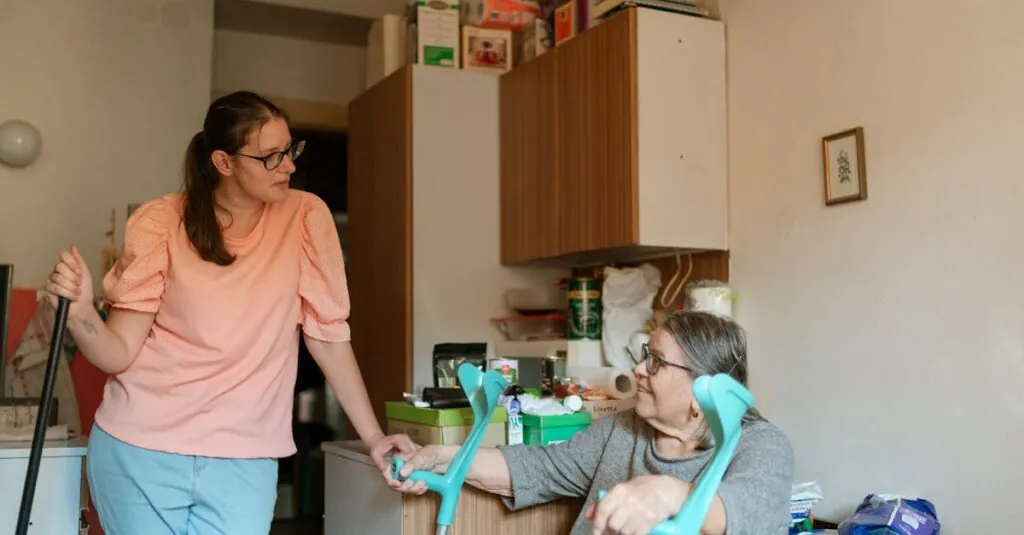Table of Contents
ToggleNavigating the world of senior housing can feel like trying to find a needle in a haystack—if that needle was a cozy apartment and the haystack was filled with confusing jargon. Luckily, HUD senior housing offers a lifeline for those seeking affordable and comfortable living arrangements. With a sprinkle of government support and a dash of community spirit, these housing options cater to the unique needs of seniors.
Overview of HUD Senior Housing
HUD senior housing encompasses a variety of programs designed to provide safe, affordable living options for older adults. The U.S. Department of Housing and Urban Development (HUD) plays a crucial role in this sector by offering financial assistance and resources. With multiple types of housing available, options include public housing, Section 202 supportive housing for the elderly, and Section 8 vouchers.
Public housing offers low-cost rental units specifically for low-income seniors. Section 202 supportive housing combines affordable rent with supportive services to help residents manage daily activities. Section 8 vouchers enable eligible seniors to find housing in the private market while subsidizing their rent.
Eligibility for HUD senior housing generally depends on income, age, and family size. Seniors often must have an income at or below 50% of the area median to qualify. Applications are frequently processed through local Public Housing Authorities (PHAs), which administer these programs.
Various amenities may be available in HUD senior housing communities. Common features include accessibility options, social activities, and transportation services. Many communities prioritize creating a supportive environment where seniors can connect with peers.
Supportive services offered in some HUD housing options can include meal programs, health screenings, and assistance with daily tasks. These services enhance the quality of life for residents and promote independence.
HUD’s commitment to improving housing conditions for seniors remains vital. Ongoing support from federal and local agencies helps address the diverse needs of older adults. By providing affordable housing solutions, HUD plays an essential part in ensuring senior citizens have safe and comfortable places to call home.
Types of HUD Senior Housing Options
Various HUD senior housing options exist to meet the diverse needs of older adults. Each category provides important resources and support for comfortable living.
Public Housing
Public housing offers affordable rental units owned by local housing authorities. Eligible seniors can access these units based on their income, which generally must fall below 50% of the area median. Many public housing complexes provide essential services, such as maintenance and security, ensuring a safe environment. Community spaces often facilitate social interaction among residents, fostering a sense of belonging. Applicants may face a waiting list due to high demand, highlighting the importance of early application.
Section 202 Supportive Housing for the Elderly
Section 202 supportive housing focuses on serving low-income elderly individuals. These projects combine affordable housing with supportive services, promoting independence. Assistance may include transportation, meal programs, and social activities tailored to enhance quality of life. Eligible seniors typically must be 62 years or older, with income requirements aligned with local median levels. Each Section 202 property aims to create a safe and welcoming community, supporting residents’ well-being and helping them thrive.
Eligibility Requirements for HUD Senior Housing
Eligibility for HUD senior housing involves specific criteria that applicants must meet. Age is a primary factor, as most programs require individuals to be at least 62 years old. Income limits also play a significant role in determining eligibility, typically based on the area’s median income. Generally, seniors qualify if their income is at or below 50% of the median for their locality.
Family size affects eligibility as well. Applicants with larger households may have higher income limits. Different programs cater to various needs, so reviewing each option can clarify specific requirements. Public housing, for instance, focuses on low-income seniors seeking affordable rent, while Section 202 provides supportive services alongside housing.
Citizenship status may further impact eligibility. Most programs require applicants to be U.S. citizens or have eligible immigration status. Additional documentation may be necessary to verify income levels and family size. Providing accurate information streamlines the application process and enhances approval chances.
Applicants often need to undergo a background check to ensure compliance with program guidelines. Past interactions with housing authorities can influence eligibility outcomes, so maintaining a good record proves beneficial. Various resources are available to assist applicants in understanding and meeting eligibility requirements. Local housing offices offer guidance and support, making the process more accessible for seniors seeking stable, affordable housing.
Benefits of HUD Senior Housing
HUD senior housing offers numerous advantages that cater to the unique needs of older adults. These benefits include affordability and accessibility, both crucial for enhancing the quality of life for seniors.
Affordability
Affordability stands out as a primary benefit of HUD senior housing. Many units are available to individuals with incomes at or below 50% of the area median income. Rent in public housing is often set based on income, ensuring residents can manage expenses effectively. Subsidized options, such as Section 8 vouchers, enable seniors to live in a variety of neighborhoods while maintaining financial stability. Minimum up-front costs ensure that seniors don’t face significant financial burdens when moving. Direct assistance addresses basic needs without compromising on comfort or security. Programs tailored specifically for low-income seniors provide additional resources, making housing costs more manageable.
Accessibility
Accessibility enhances the appeal of HUD senior housing. Most properties are designed with the physical limitations of older adults in mind, featuring features such as wheelchair ramps and handrails. Community interactions foster social engagement, promoting mental well-being. Transportation options often support those who no longer drive, ensuring residents can access essential services like grocery stores and medical facilities. Nearby amenities cater to the lifestyle and mobility requirements of seniors, creating convenient living situations. Local housing authorities work diligently to keep environments safe and welcoming for all residents, ensuring essential services are within reach.
Challenges in HUD Senior Housing
HUD senior housing presents various challenges for seniors navigating their options. Key concerns include waiting lists and maintenance issues, which can hinder access to suitable living arrangements.
Waiting Lists
Long waiting lists often complicate the search for affordable housing. Seniors applying for supportive housing may face delays that extend for months or even years, reducing immediate options. High demand for public housing units contributes to these prolonged waiting periods. Many applicants remain hopeful but often encounter frustration as they await available spots. Regular updates from local housing authorities help keep seniors informed about their application status and estimated wait times.
Maintenance Issues
Maintenance issues pose another significant challenge in HUD senior housing. Property owners must adhere to specific standards, yet many struggle to provide timely repairs and upkeep. Aging infrastructure can lead to malfunctioning appliances or plumbing concerns, affecting residents’ daily lives. Response times for maintenance requests may vary, contributing to dissatisfaction among tenants. Residents often rely on community advocates to address persistent problems, highlighting the need for improved maintenance practices across HUD properties.
Conclusion
Navigating the landscape of senior housing can be daunting but HUD senior housing stands out as a beacon of hope for many older adults. With its focus on affordability and accessibility it provides essential resources that cater to the unique needs of seniors. The variety of options available ensures that individuals can find suitable living arrangements that enhance their quality of life.
While challenges like long waiting lists and maintenance issues persist it’s crucial for community advocates to continue pushing for improvements. The commitment of HUD and local housing authorities to create safe and welcoming environments is vital for supporting the well-being and independence of seniors. As awareness grows about these housing options more seniors can find the stability and comfort they deserve.




